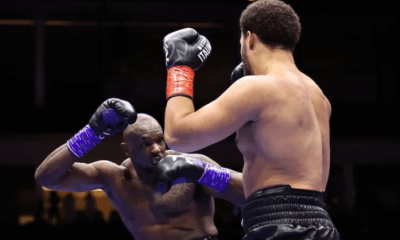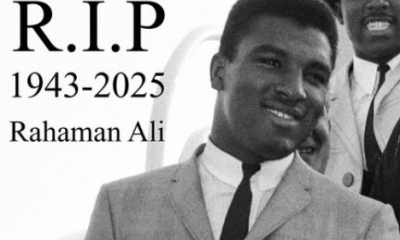Featured Articles
UFC vs Boxing; Also, “Tapped Out”
Last Saturday saw the epic trilogy of Pacquiao-Marquez conclude on a sour note while simultaneously, the UFC had its (brief) debut appearance on FOX terrestrial with the Junior Dos Santos-Cain Velasquez heavyweight title fight. Contrasting the two events helps us revisit the ongoing debate over the business models of the UFC versus big-time boxing.
The goal of airing the Dos Santos-Velasquez fight—won via stoppage by the Brazilian in 64 seconds—on network television was to increase the visibility of the UFC. It’s hoped that the exposure will gain new fans to purchase future UFC pay-per-views. Looking at the lackluster estimated buy-rates from UFC 130 to UFC 136, only Jon Jones vs Rampage breaks the 400,000 mark (source: http://mmapayout.com/blue-book/pay-per-view).
Contrast the plight of the UFC to boxing, where Manny Pacquiao’s name alone commands respect and massive interest among fight fans everywhere. The big hook going into Pacquiao-Marquez III was the question of how much danger was posed by Juan Manuel Marquez. In boxing, this was a significant fight to understand both the technical brilliance of JMM while questioning whether Manny is an improved fighter from their previous two encounters.
Boxing has declined from the mainstream coverage and interest it was given in previous decades, however, this does not mean that mid-tier UFC fight cards represent the future. The closest the UFC can come to matching the PPV numbers pulled by Manny Pacquiao or Floyd Mayweather Junior is when UFC stars like Georges St-Pierre and Brock Lesnar fight. Since Lesnar and GSP only manage a couple fights a year these days, they are hardly a threat to boxing as a whole and will not displace any revenue for the bigger fights.
UFC 137, headlined by BJ Penn and Nick Diaz, was estimated to have done 280,000 buys by Dave Meltzer. The card was hurt severely by the absence of Georges St-Pierre, who intends to face Nick Diaz early next year after rehabbing from a knee injury.
St-Pierre recently told Agence France-Presse that he clears $4 to $5 million per fight, and hinted that he might want a career change by the time he is 36 years of age. In truth, St-Pierre’s continued dominance of the welterweight division is the safe bet the UFC can bank on for future profits. Perhaps exposure on FOX will help the French-Canadian bank an even larger retirement fund for his future.
***
November 17th sees the launch of an MMA memoir similar to Sam Sheridan’s ‘A Fighter’s Heart’ in Matthew Polly’s ‘Tapped Out: Rear Naked Chokes, the Octagon, and the Last Emperor. An Odyssey In Mixed Martial Arts’ (Gotham Books).
Polly, a national bestselling author, Princeton University graduate and Rhodes scholar, decides to attempt a foray into MMA. He utilizes the crème de la crème of coaching staff: Georges St-Pierre’s New York-based Muay Thai and Brazilian Jiu-Jitsu trainers, as well as the top instructors at Xtreme Couture’s Las Vegas gym in order to prepare him for an MMA fight.
Almost no expense is spared in obtaining training, from a trip to Thailand to a six month training camp in Las Vegas. Joining Renzo Gracie’s New York academy cost $250 a month under the year-long contact; private lessons with BJJ black belt John Danaher and Kru Phil Nurse at the WAT set Polly back even further.
The undercurrent to the entire memoir involves a mix between Polly’s anxieties over the damage done to combatants in MMA coupled with his fierce competitive nature—so much so that he nearly attempts a leglock on Danaher’s bad knee in an attempt to submit him. While practicing the Thai clinch with Nurse, Polly managed to hurt the Muay Thai expert with a knee; Phil’s own competitive nature responded with a hard knee that had Polly gasping for breath.
Sprinkled into the narrative includes a meeting with legend Fedor Emelianenko—in Russia, no less—and an encounter with pound-for-pound welterweight king Georges St-Pierre, who is a regular at the WAT. While neither interview yields any opening into the depths of Fedor or GSP’s character, the style of questions reveals much about Polly’s attitude.
You have to give credit to the author for making a huge investment in proper training, the opportunity cost that he could have spent on more lucrative gigs, as well as the emotional pain Polly endured on the road to glory. Meeting Daniel Day Lewis at the WAT (the actor has known Phil Nurse for years) and competing in a kickboxing smoker refereed by Randy Couture himself were unexpected bonuses that occurred under a very difficult set of circumstances.
Polly manages to obtain special insight into MMA fighters. In a sparring session with Ryan Couture, a vicious and well-placed leg kick from Couture requires immediate ice on the author’s leg. Ryan—a fierce striker—still takes the time to make sure Polly is ok.
“It was one of the things I liked most about MMA fighters. They didn’t mind putting a little hurt on a teammate, but they never wanted to cause an injury. They wanted to win, often desperately, but not at the expense of permanent damage.”
On the downside, we also get access to the darker side of fighters’ psyches. For instance, during the pro class at Xtreme Vegas, Bellator contender Jay Hieron engages in a stand-up only sparring session with a higher caliber kickboxer from Ireland. Rather than accept being outboxed, Hieron takes his sparring partner down, and delivers strikes on the ground. No one enjoys being beat, even in training—but Hieron’s actions were disrespectful. Does Nick Diaz take Andre Ward down if he’s getting outboxed in the gym? What about Georges St-Pierre at Grant Brothers in Montreal? You have to accept that there are reasons why GSP is the number one welterweight while Nick Diaz is the number one contender; their ability to play to the strengths of others is part of their success.
Where does Polly go after winning his MMA debut? Does he keep putting in hard hours on the mat at the local (legit) jiu-jitsu academy? Will he pare his training down to a manageable 1-2 days a week in public classes? Or does he quit martial arts once again, since his goal is completed? At what point can he really tell the audience that he’s proved everything he wanted to find out about himself?
‘Tapped Out’ is a finite journey that ends after 280 pages, but for the aficionados of the sport, the adventure always continues as there is always another challenge on the horizon calling for someone brave enough to surmount it.
Brian J. D’Souza is a Canadian writer who has covered Mixed Martial Arts for ESPN.com, FoxSports.com and FIGHT! magazine.
Video trailer for the book here: http://www.youtube.com/watch?v=OW9v4tv5YEY
Amazon.com link: http://www.amazon.com/Tapped-Out-Octagon-Emperor-Odyssey/dp/1592405991/ref=sr_1_1?s=books&;ie=UTF8&qid=1321270724&sr=1-1
-

 Featured Articles4 weeks ago
Featured Articles4 weeks agoThe Hauser Report: Zayas-Garcia, Pacquiao, Usyk, and the NYSAC
-

 Featured Articles3 weeks ago
Featured Articles3 weeks agoOscar Duarte and Regis Prograis Prevail on an Action-Packed Fight Card in Chicago
-

 Featured Articles2 weeks ago
Featured Articles2 weeks agoThe Hauser Report: Cinematic and Literary Notes
-

 Book Review2 weeks ago
Book Review2 weeks agoMark Kriegel’s New Book About Mike Tyson is a Must-Read
-

 Featured Articles4 weeks ago
Featured Articles4 weeks agoRemembering Dwight Muhammad Qawi (1953-2025) and his Triumphant Return to Prison
-

 Featured Articles7 days ago
Featured Articles7 days agoMoses Itauma Continues his Rapid Rise; Steamrolls Dillian Whyte in Riyadh
-

 Featured Articles3 weeks ago
Featured Articles3 weeks agoRahaman Ali (1943-2025)
-

 Featured Articles3 weeks ago
Featured Articles3 weeks agoTop Rank Boxing is in Limbo, but that Hasn’t Benched Robert Garcia’s Up-and-Comers













